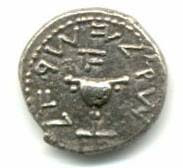CNN: German battlefield yields Roman surprises
Its not the site of the battle where the Germans in the time of Augustus when in 9 C.E. they defeated P. Quinctilius Varus and destroyed three Roman legions, but a later battle, in the third century C.E.
Archaeologists have found more than 600 relics from a huge battle between a Roman army and Barbarians in the third century, long after historians believed Rome had given up control of northern Germany.
"We have to write our history books new, because what we thought was that the activities of the Romans ended at nine or 10 (years) after Christ," said Lutz Stratmann, science minister for the German state of Lower Saxony. "Now we know that it must be 200 or 250 after that."
For weeks, archeologist Petra Loenne and her team have been searching this area with metal detectors, pulling hundreds of ancient Roman weapons out of the ground. They paint a picture of a highly organized, technologically superior Roman army beset by Germanic tribes in a forest about 80 km (50 miles) south of the modern city of Hanover.
The hillside battlefield was discovered by relic-hunters illegally searching for souvenirs of more recent wars near the town of Kalefeld-Oldenrode. One of them brought some of the items he found to Loenne, who works for the local government.
The artifacts are so well preserved that the scientists can already retrace some of the battle lines. Video Watch how the battlefield discovery could re-write history »
"We believe the Germans ambushed the Romans here, but the legions quickly fired back with catapults and archers -- and then it came to a massive man-on-man onslaught," Loenne said.
The items unearthed so far include an axe, still sharp after nearly 1,800 years; horseshoes; shovels; spearheads; and dozens of arrowheads for a Scorpio, a cross between a catapult and a crossbow -- the ancient equivalent of artillery.
Coins were also found, from the reign of the Roman Emperor Commodus (161-192 C.E.), which aids in identifying the time period of the battle. The coins, coupled with the Roman armor and weaponry they are recovering should help give a good estimate as to when the battle was fought.
A very interesting find, and as the archaerlogist quoted in the CNN article notes, one that will revise our knowledge of the extent and influence of the Roman Empire in the third century.

No comments:
Post a Comment